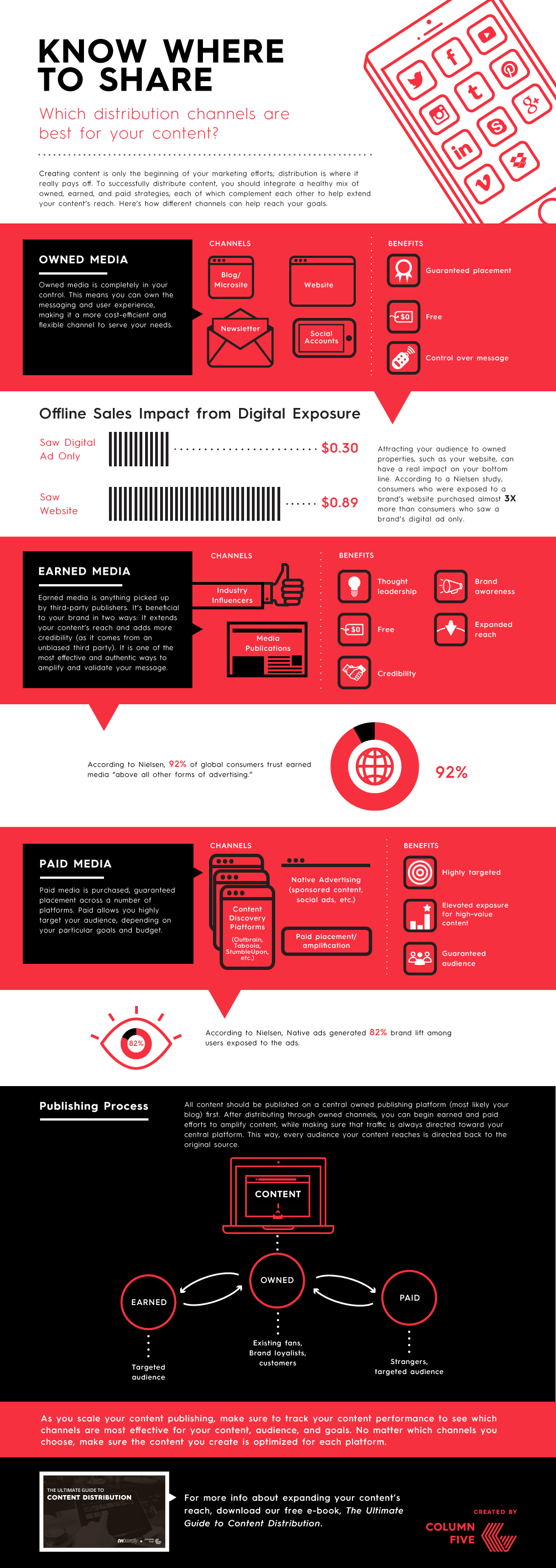Your content needs to reach the right people to move the needle, but with so many distribution channels it’s hard to know where to put your efforts—especially when you want to maximize your resources and get the best ROI. So how do you choose the channels that will work for your specific content strategy? We’re here to help. 
6 Steps to Choose the Right Distribution Channels
Choosing the right channels isn’t about guesswork. You need to take a strategic approach to identify what will work for you—and make sure you get the results you want. Here’s how to do it.
1) Know your goal.
To choose the right channels, you don’t focus on the channels. First, you focus on what you’re trying to achieve. Identify what your specific goal is. Boosting engagement? Growing followers? Driving web traffic?
Document your goal so that everyone on your team is on the same page. The good news is the more clarity you have about your goal, the easier it is to find the right channels.
Tip: Be specific as possible. “General awareness” isn’t as clear as “10,000 Twitter followers.”
2) Know your audience.
Whether you’re a B2B or B2C brand, the more you understand your audience—who they are, what they need, and how you serve them—the better you can connect with them. When it comes to your content strategy, your audience should influence everything you do, from the ideas you brainstorm, to the content formats you choose, to the places you distribute that content.
Before you worry about distribution channels, make sure you know who you’re trying to reach, specifically their:
- Age
- Gender
- Location/target area
- Pain points
- Goals
- How your product/service solves their problems
With that knowledge, think about where you can most effectively reach them.
- Where do they get their news?
- What sites do they frequent?
- What social platforms do they enjoy?
- Which platforms do they spend the most time on?
- What formats (video, photo, etc.) do they like to engage with on those platforms?
The answers to these questions should give you a general list of channels to consider.
Tip: Having accurate personas is crucial to create an effective content strategy. If yours need some updating, follow our guide to create personas.
3) Identify your channels.
With an intimate understanding of your audience, you can now assemble a list of all the channels that are most likely to help you reach the right people.
There are three main avenues you want to consider, and within those are specific platforms to target.
- Owned: These are the channels that belong to your company specifically.
- Website
- Blog
- Newsletter
- Company social media accounts (Twitter, FB, LinkedIn, etc.)
- Etc.
- Earned: This is organic distribution from a third-party that you don’t pay for—basically free promotion.
- Coverage in an industry publication
- Fans or influencers sharing your content on social
- Directories
- Etc.
- Paid: This is all the distribution you pay for.
- Sponsored social media campaigns (content, ads, etc.)
- Partnerships (social media influencers, brand collaborations etc.)
- Paid editorial in publications
- Other media buys (print, TV, radio, digital, etc.)
- Etc.
Note: You have the least control over earned media because it relies on others’ actions. Thus, most of your efforts will likely be in the paid space, where you can get the best bang for your buck.

Tip: If you want to outshine your competition, find out where they distribute their conten with our guide to do a competitive content audit.
4) Prioritize your top channels.
Even if you have endless resources, you still want to focus your efforts strategically.
Once you’ve identified your main avenues, do some deeper research to identify which specific platforms are most likely to help you achieve your goals—and give you the maximum ROI.
To narrow it down, consider…
- Reach: Where does your audience live online? What platforms do they use? Where do they spend most of their time?
- Budget: What amount of budget have you set aside for distribution efforts? How far will that budget go on each platform? For example, LinkedIn costs more to advertise on than Facebook, but if it’s where your audience is, it is more effective to run a smaller, more effective campaign there than a larger campaign on Facebook. One easy way to decide between distribution channels is to make a dummy campaign. That way you can get a sense of what your options are in terms of audience targeting—before investing money.
- Time: How much energy does it take to run and manage your campaigns? Beyond paid campaigns, some platforms require more investment than others to engage and grow your audience, especially if you’re new to the platform. For example, Twitter is a high maintenance channel, as it requires multiple posts a day to stay actively engaged, whereas you can maintain a presence on Instagram or Facebook with one post a day.
Tip: Before you start targeting your preferred channels, make sure your content is optimized for distribution. Consider things like image size, keywords, functionality, etc. To start, see our guide to optimize your blog.
5) Determine your measurement approach.
Whereas your goal and audience are key drivers in what you decide to do, you need to figure out how to determine if what you’re doing is successful. To decide what to measure, use your goal as the benchmark. The better you measure, the better insights you’ll get to improve your distribution strategy all around.
Tip: For more on measuring your goals, see our guide to choose the right metrics for your distribution strategy.
6) Test and tweak.
Testing is the most important part of the process, helping you improve your results for individual campaigns and improve future campaigns, too.
But when you’re first starting out, look at testing as a way to get information, not necessarily results. (If you get results off the bat, that’s awesome, but focus on learning first.)
- Test your priority channels first. Don’t throw money at every single channel. To get your bearings, start by testing two distribution channels at a time. This way you can strategically compare. (If two channels are similar in spend, divide your budget evenly.)
- Double check that everything is set up correctly. Once you set up your test, revisit it the next day to confirm it’s accurate (e.g., you’re targeting the correct audience).
- Run your tests for a month. This gives you four weeks of good data to inform your decisions. However, keep an eye on them throughout the four weeks. Be especially attentive during week one to ensure that you are seeing some results. If nothing is working, you can tweak your targeting so that you’re optimizing your test budget fully. You can refine throughout the campaign, but if you’re seeing positive results in the first two weeks, let it ride throughout the test so you get 2-3 weeks of solid data to analyze before launching your final campaign.
Tip: Reserve a portion of your budget for contingency planning—say, 10%. If something in your testing goes wrong (e.g., you ran a campaign for too long), that contingency budget can act as a safety net. If something works really well off the bat, you can use that budget to increase your results.
How to Strengthen Your Distribution Strategy
Your distribution strategy isn’t a “set it and forget it” kind of thing. The more you learn, the more you can improve and get the best results possible. Going forward…
- Revisit your channels. As your goals change or your business shifts, you’ll need to adjust your distribution strategy. Review once a quarter to make sure you’re targeting the right distribution channels.
- Set yourself up for success. See our distribution strategy checklist to make sure you are working as effectively as possible.
- Follow best practices. To implement your strategy effectively, find out what common content distribution mistakes to avoid.
For more tips on getting your content in front of the right people, download our Ultimate Guide to Content Distribution. And if you need a partner to help you reach the right people, holler at us.
Note: Originally published in 2014, this post has been updated to reflect current best practices.





Comments